UK Edition Change
- UK Politics
- News Videos
- Paris 2024 Olympics
- Rugby Union
- Sport Videos
- John Rentoul
- Mary Dejevsky
- Andrew Grice
- Sean O’Grady
- Photography
- Theatre & Dance
- Culture Videos
- Fitness & Wellbeing
- Food & Drink
- Health & Families
- Royal Family
- Electric Vehicles
- Car Insurance Deals
- Lifestyle Videos
- Hotel Reviews
- News & Advice
- Simon Calder
- Australia & New Zealand
- South America
- C. America & Caribbean
- Middle East
- Politics Explained
- News Analysis
- Today’s Edition
- Home & Garden
- Broadband deals
- Fashion & Beauty
- Travel & Outdoors
- Sports & Fitness
- Climate 100
- Sustainable Living
- Climate Videos
- Solar Panels
- Behind The Headlines
- On The Ground
- Decomplicated
- You Ask The Questions
- Binge Watch
- Travel Smart
- Watch on your TV
- Crosswords & Puzzles
- Most Commented
- Newsletters
- Ask Me Anything
- Virtual Events
- Wine Offers
- Betting Sites

Thank you for registering
Please refresh the page or navigate to another page on the site to be automatically logged in Please refresh your browser to be logged in
How Nepal's tourist industry is bouncing back two years on from devastating earthquake
April 25 marks two years since an earthquake left nepal in ruins – but tourism is slowly recovering, article bookmarked.
Find your bookmarks in your Independent Premium section, under my profile
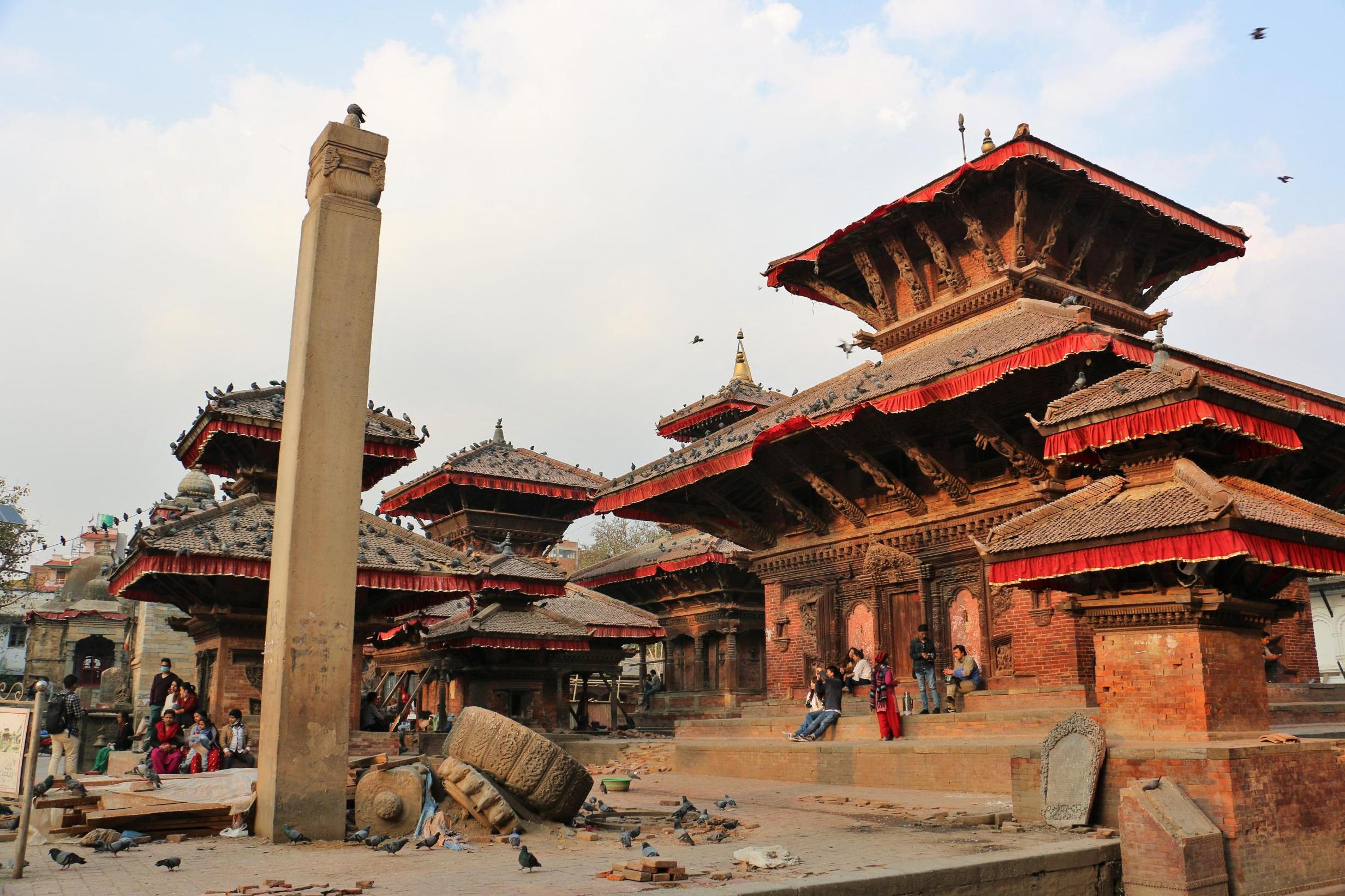
Sign up to Simon Calder’s free travel email for expert advice and money-saving discounts
Get simon calder’s travel email, thanks for signing up to the simon calder’s travel email.
Few of us can forget the harrowing images that flooded the media in the weeks that followed 25 April 2015 – the day a devastating earthquake shook Nepal to its core. Shocking scenes of bodies being pulled from mountains of rubble and centuries’ old temples reduced to dust captured the world’s attention. The tremor, which measured 7.8 on the Richter scale, was responsible for leaving nearly 9,000 dead, 22,000 injured and several million people without homes.
For months the country was in crisis, with food, energy supplies and infrastructure severely affected. Tourism – one of the major contributors to the country’s GDP – collapsed overnight. The impact on more than a million Nepalis whose livelihoods depend on the industry was swift and severe. Travellers stayed away , and not just in the immediate aftermath – the disaster had a prolonged effect on tourism that the country struggled to shake off. Local guides throughout Nepal report being out of work for up to seven months after the quake, even in areas that were far from the epicentre and experienced minimal damage. In 2014, 790,000 visitors came to the country. The following year, when the quake struck, that number plummeted to 539,000 – a loss of almost a third.
Visiting the country 24 months after the disaster, I learn from Suni, my guide in Kathmandu, what life was like in the aftermath: “A lot of foreigners and aid workers came to help after it happened, but tourists were slow to return. Newspapers and TV continued to show photos of the damage caused by the earthquake – even when we were ready for people to come back – and tourists were led to believe that the country was in a worse state than it actually was.”
Despite this bleak period in Nepal’s recent history, things are definitely looking up. Wandering through the heritage sites, I found the pockets of devastation didn’t detract from Nepal’s overall impressiveness. If anything, the loss of historic buildings made me appreciate how precious the remaining temples are all the more. I was struck by the resilience of the people affected by the quake and by their desire to see tourists return – but progress is slow-going in terms of reconstruction.
Kathmandu, the capital, was one of the worst affected areas, with thousands of houses destroyed. Many of these were badly built and home to some of the city’s poorest residents. Two years on, a lot of these people remain in makeshift camps awaiting money from the government so that they can rebuild. Of the billions of pounds in aid provided by foreign governments and international donors to help the reconstruction efforts, a disappointingly small amount has been dispersed in the last two years.
Nowhere in the city are the catastrophic effects of the quake more evident to travellers than in Durbar Square, an Unesco world heritage site home to a wealth of ornate temples, palaces and monuments. Plinths that once held majestic temples like Maju Dega and Trailokya Mohan Narayan now stand ominously empty. Other buildings survived but were severely damaged, including towering Basantapur Durbar, famous for its nine storeys – now reduced to seven. Many structures are supported by wooden planks, some cordoned off behind “danger zone” signs, while crumbled temples bear images showing them intact before the disaster. Wandering through Kathmandu’s most popular attraction it is impossible not to be moved by the sheer scale of the cultural loss.
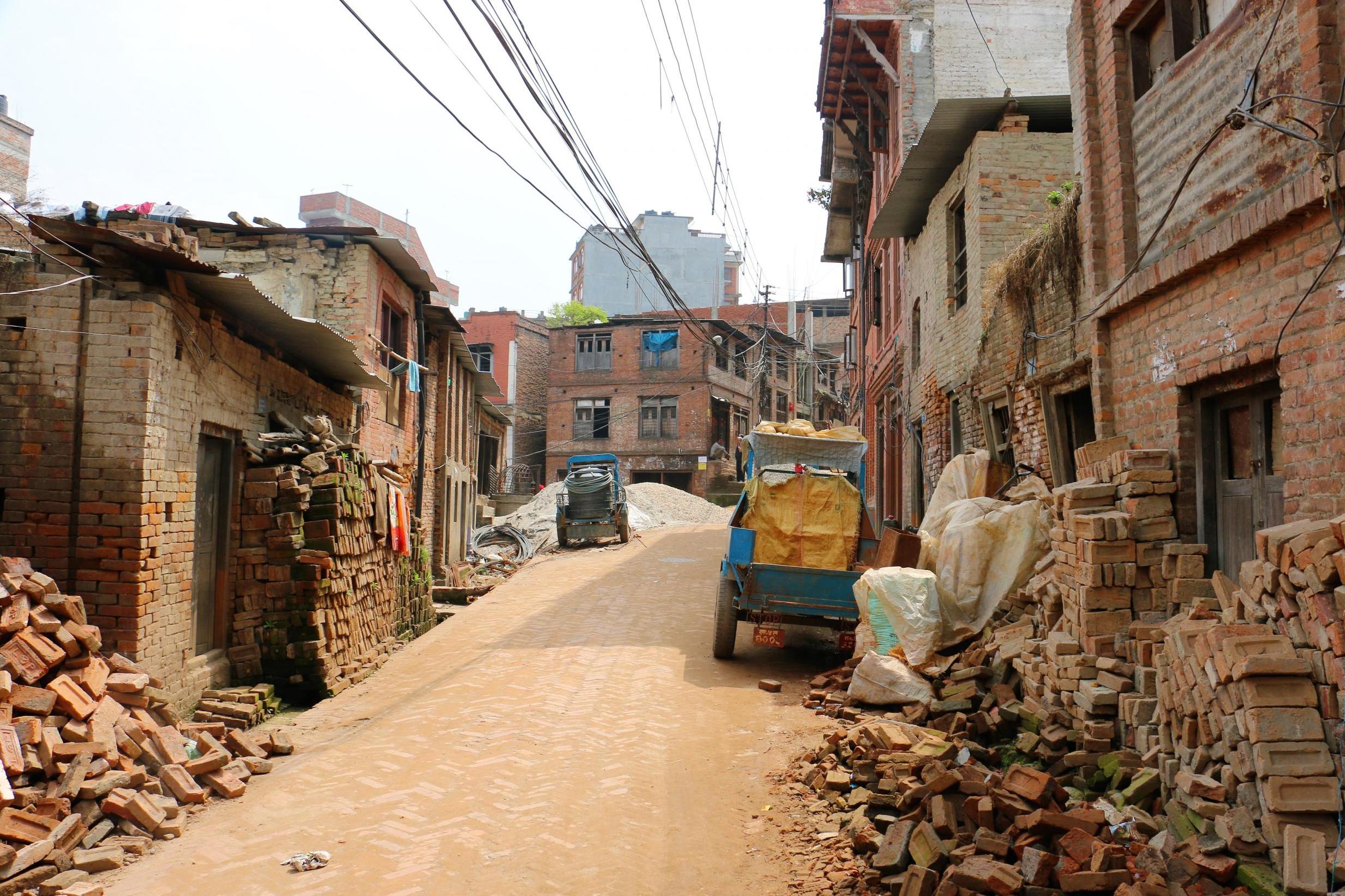
It’s a similar scene across other world heritage sites in the Kathmandu Valley. Bhaktapur, which is considered the best preserved of Nepal’s three medieval cities, was hit hard. Along with historic temples of cultural and religious importance, a significant number of traditional homes were destroyed, with many of the charming streets changed forever.
Unesco is advising the Nepalese government on how to preserve its precious cultural heritage, working closely with the country’s Department of Archaeology (DoA) – the agency responsible for post-earthquake reconstruction – as well as managing a range of projects directly. Rebuilding and restoration has been frustratingly slow and fraught with difficulties. Christian Manhart, Unesco representative to Nepal, says: “Judging by the meagre progress made over the past two years, the target of completing the restoration of 700 damaged and 133 completely destroyed monuments within five years appears out of reach. The government has recently announced that reconstruction of 20 damaged heritage monuments has been completed and at this pace that only 10 per cent of all those damaged could be reconstructed in the next five years.
“Some international organisations are experiencing the government’s extremely slow permission process, which is required for them to fund and carry out reconstruction work. There are also issues with poor quality of work, caused by the government agencies being required by law to tender projects to the lowest bidding contractors. Qualified engineers and architects are lacking too.”
For some of those who lost homes in the earthquake, the slow progress being made at heritage sites has an unfortunate knock-on effect. In Bhaktapur, restoring these sites has taken priority and it won’t be until this work is completed that attention will be turned to rebuilding homes.
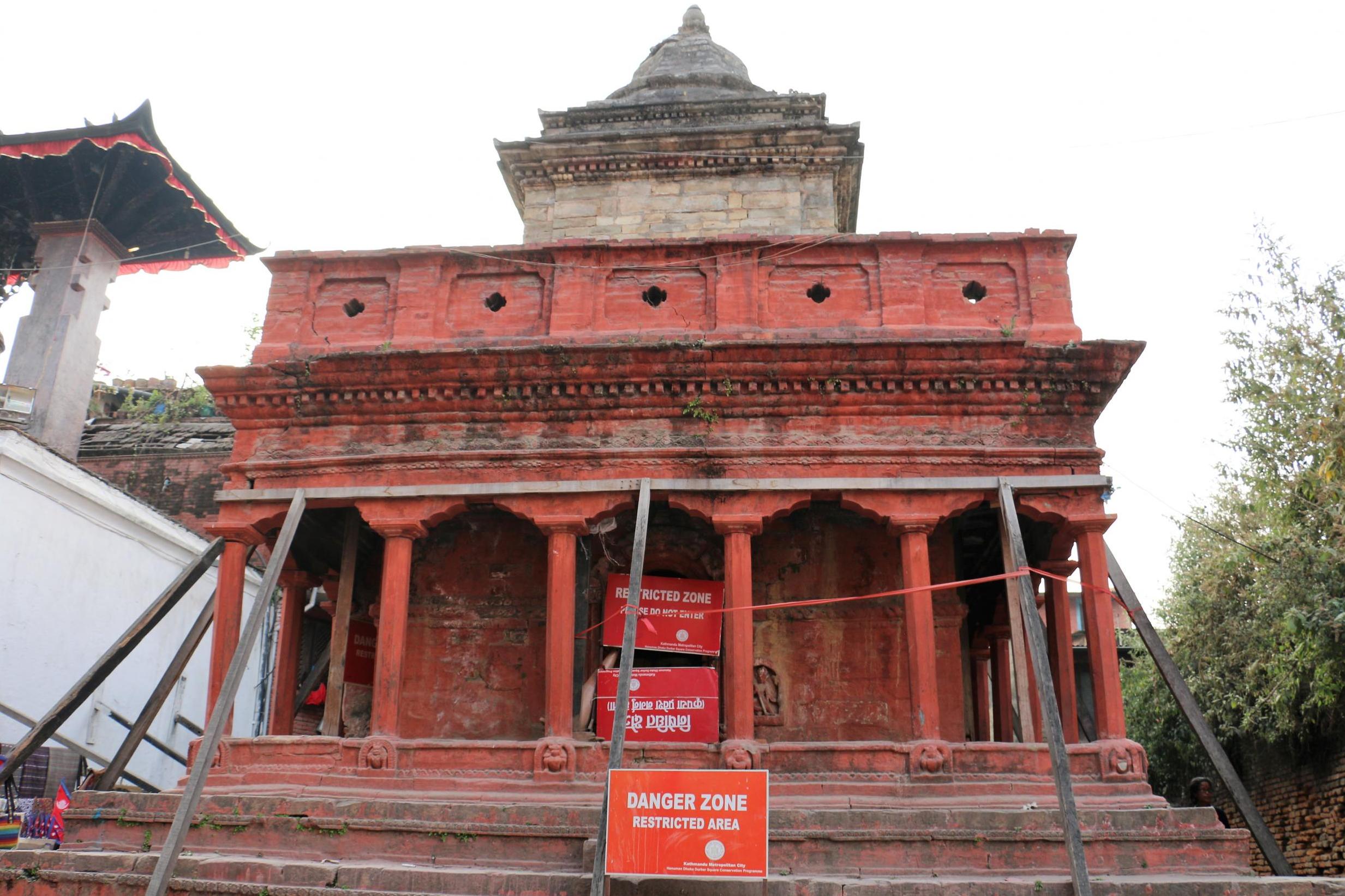
Trekking, the other pillar of Nepal’s tourism industry, has bounced back quicker, despite an avalanche triggered by the earthquake at Everest Base Camp killing 18 people and damaging villages throughout the region. Annapurna, the country’s other famous trekking region, suffered only minor damage and has regained its popularity among trekkers in the last two years.
For all that the struggles have been difficult to shake off, the future looks bright for Nepal as far as tourism is concerned. Last year saw 753,000 tourists return to the country – only 37,000 fewer than the year before the quake. The scars of the biggest natural disaster to hit the country in more than 80 years may be visible for many years to come, but for travellers there still remains an abundance of cultural and natural treasures to enjoy. Having visited many countries where I’ve felt that the locals view tourism as a necessary evil, in Nepal there was nothing but warmth from everyone I met, whether hiking in a remote Himalayan village or on the busy streets of Kathmandu. The nation’s famously friendly people are Nepal’s greatest asset – and that’s something no earthquake can destroy.
Join our commenting forum
Join thought-provoking conversations, follow other Independent readers and see their replies
Subscribe to Independent Premium to bookmark this article
Want to bookmark your favourite articles and stories to read or reference later? Start your Independent Premium subscription today.
New to The Independent?
Or if you would prefer:
Hi {{indy.fullName}}
- My Independent Premium
- Account details
- Help centre

- GSTC Mission & Impacts
- GSTC History
- Market Access Program
- GSTC Board of Directors
- Assurance Panel
- Working Groups
- GSTC Sponsors
- GSTC Members
- Recruitment
- Contact GSTC
- GSTC For the Press
- Criteria Development, Feedback & Revisions
- GSTC Early Adopter Programs
- Sustainable Tourism Glossary
- SDGs and GSTC Criteria
- GSTC Industry Criteria
- GSTC Destination Criteria
- GSTC MICE Criteria
- Criteria Translations
- GSTC-Recognized Standards for Hotels
- GSTC-Recognized Standards for Tour Operators
- GSTC-Recognized Standards for Destinations
- Recognition of Standards (for Standard Owners)
- GSTC-Committed
- Certification for Hotels
- Certification for Tour Operator
- Certification for Destination
- What is Certification? Accreditation? Recognition?
- GSTC Accreditation
- Accredited Certification Bodies
- Accreditation Documents
- CS-CB Framework
- Public Consultations
- GSTC Auditor Training
- Sustainable Tourism Training Program (STTP)
- Upcoming Courses
- Professional Certificate in Sustainable Tourism
- Professional Certificate in Sustainable Business Travel
- GSTC Trainers and Partners
- FAQs: GSTC Training Program
- Organization Membership Application
- Destination Membership Application
- Membership Policy
- Membership Categories & Fees
- Membership Payment Options
- Webinars for GSTC Members
- Members Log In
- Upcoming Webinars
- GSTC2024 Singapore, Nov 13-16
- Upcoming Conferences
- Past Conferences
- Destination Stewardship Report
Tourism and Natural Disaster Recovery: Keys to Success
Destination stewardship report – autumn 2023 (volume 4, issue 2).
This post is from the Destination Stewardship Report ( Autumn 2023, Volume 4, Issue 2 ), a publication that provides practical information and insights useful to anyone whose work or interests involve improving destination stewardship in a post-pandemic world.

Before and after pictures of Durbar square in Kathmandu. [Photo courtesy of National Geographic]
What is the impact of natural disasters on tourism and how can the tourism industry itself promote recovery for the destination? Examining Nepal’s recovery following the Gorkha Earthquake in 2015, Jacqueline Harper shares insights into the role of tourism in disaster recovery, emphasizing the significance of swift recovery, effective destination marketing, strategic partnerships, and the opportunity to build back better through sustainable and community-focused approaches.
How tourism can help a tourist destination recover after a natural disaster
In the wake of the Maui fires, earthquakes in Morocco, a new 2023 quake in remote western Nepal, and other recent natural and manmade disasters, tourism officials have been contemplating when to resume their tourism operations. This dilemma is not uncommon. Re-opening too soon can endanger tourists’ safety; add pressure to already taxed infrastructure, accommodations, and resources; and re-traumatize residents when tourists ask how they were affected by the disaster. On the other hand, tourism and the resumption of business activities is urgently needed to fuel the speedy recovery and rebuilding of the devastated local economy.
The Gorkha Earthquake in Nepal is a case study of how tourism can aid in disaster recovery. On April 25th, 2015, the Gorkha region of Nepal was the epicenter of a 7.8 magnitude earthquake. Hundreds of aftershocks occurred for months afterward, leaving a serious impact on the country’s infrastructure, including many heritage sites that double as tourist sites. Thousands of people were injured and died. Damages cost approximately $7 billion USD, and impacted about one-third of the population. In terms of tourist arrivals, after 6 months, visitor numbers had declined by 42%.
I spent 3 months in the Kathmandu Valley researching how tourism can help a tourist destination recover after a natural disaster and gained four key insights:
1. There was a quick time frame for tourism to return to normal levels.
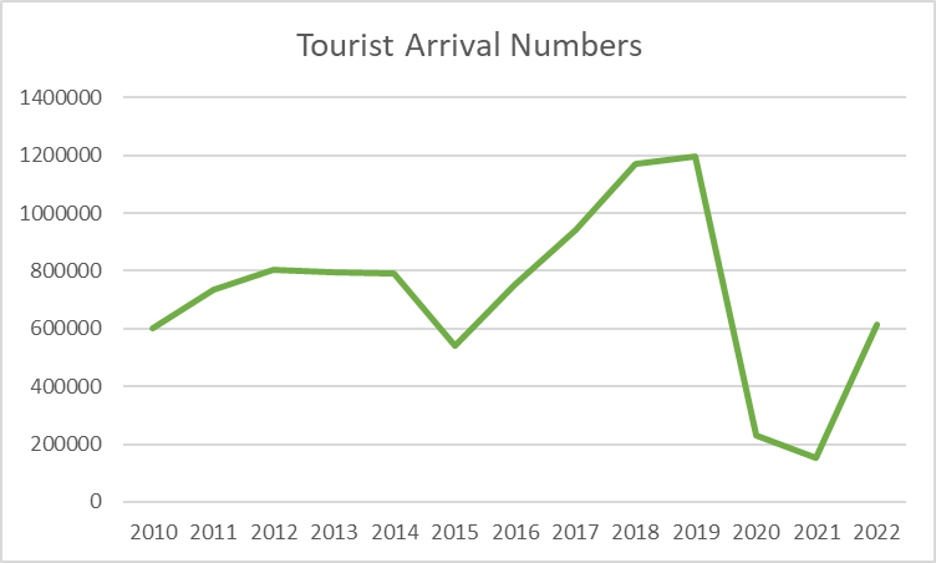
Tourist Arrival Numbers from 2010 to 2022. [Tourist Arrival Numbers received from the Ministry of Culture, Tourism & Civil Aviation]
2. Destination marketing played a critical role in the post-disaster tourism recovery.
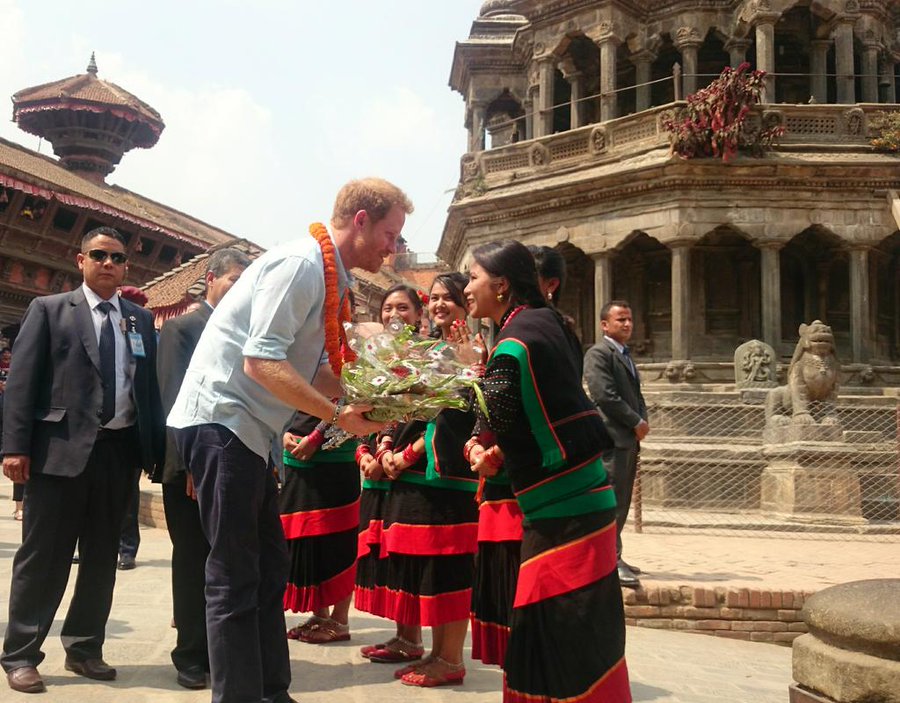
Prince Harry visiting Patan Durbar Square to view ongoing efforts to restore one of Nepal’s cultural treasures. [Photo courtesy of Jacqueline Harper]
NTB invited celebrities in key market groups to come to Nepal and highlight its tourism offerings: Jackie Chan, David Beckham, and Prince Harry, to name a few. This sparked conversation in the international news and demonstrated to international markets that Nepal was once again open for tourism. Additionally, representatives from NTB were sent on international roadshows to promote Nepal to tourism agencies, who would then promote traveling to Nepal within their own countries.

Norie Quintos, a communications and content consultant, posing in front of an “I am in Nepal Now” sign in June 2019, while visiting the Himalayan Travel Mart conference. [Photo courtesy of Jacqueline Harper]
Between 2017 and 2019, NTB organized travel conferences inviting international press and journalists to come to Nepal and experience a location, such as Pokhara. In turn, they would write about it, and promote Nepal to foreign audiences. These different methods allowed the NTB to rewrite the narrative of the country post-disaster and promote tourism once again.
3. Partnerships are key to disaster and tourism recovery.
The success of Nepal’s disaster recovery was also due to partnerships. NTB worked with news outlets like BBC, CNN, and TripAdvisor to get the message out that one could safely travel to Nepal. They also had financial and technical support from other countries like Japan International Cooperation Agency, China Aid, USAID to rebuild heritage sites. International Knowledge of tourism recovery came from PATA, the World Bank, and UNWTO to help with the tourism recovery. International partnerships were key for rebuilding and financing the recovery, but also marketing the country to foreign markets.
4. Disasters are an opportunity to build back better within the tourism industry.
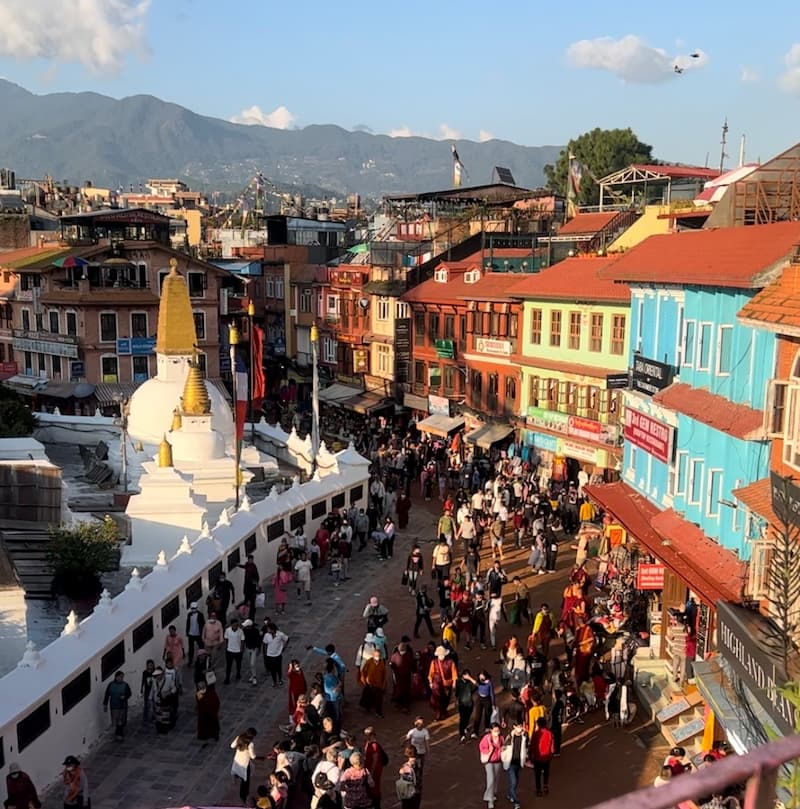
Tourists and locals make their way around the Bouddha Stupa in Kathmandu, Nepal. [Photo courtesy of Jacqueline Harper]
For example, New Zealand’s response to the Christchurch earthquake, with its focus on sustainability and community involvement, is a prime example of (1) sustainable rebuilding, (2) community engagement, (3) promotion of local businesses, and (4) resilience and adaptation.
- After the devastating earthquakes in 2010 and 2011, Christchurch embarked on a journey of sustainable rebuilding. This involved not just reconstructing damaged infrastructure but doing so with an emphasis on eco-friendly and resilient designs. Many buildings incorporated modern earthquake-resistant features and energy-efficient technologies.
- A critical aspect of the recovery was the involvement of the local community. Residents were encouraged to participate in the decision-making process, allowing them to have a say in how their city would be reimagined. This engagement ensured that the rebuilt city reflected the desires and needs of the people who call it home.
- In the aftermath of the disaster, there was a concerted effort to support and promote local businesses. The “Shop the Sirens” campaign encouraged residents and visitors to shop at local stores, helping these businesses recover and thrive.
- The earthquake catalyzed Christchurch to become more resilient in the face of future disasters. The city implemented comprehensive disaster preparedness and risk reduction strategies to mitigate the impact of any future seismic events. By following the path of building back better, destinations can not only recover but emerge stronger, ensuring that the benefits of tourism extend to all and that they are better prepared to face any future challenges that come their way.
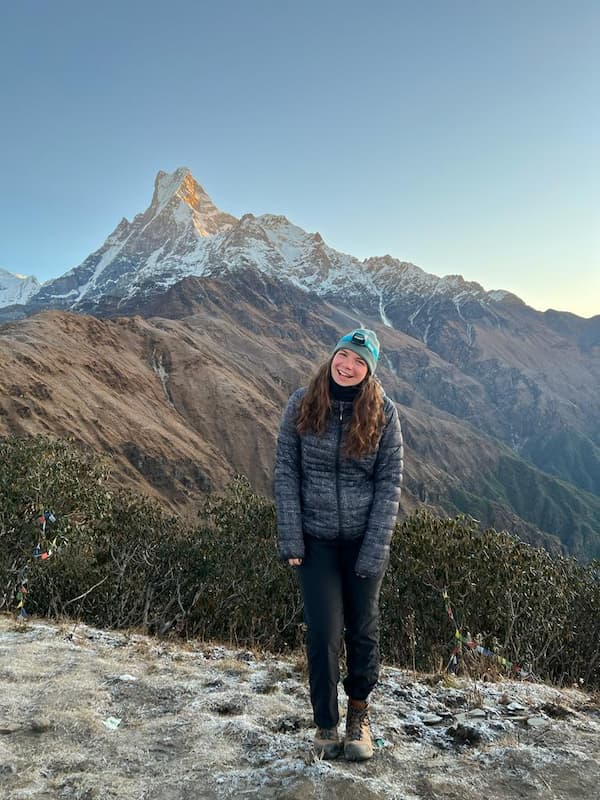
About the Author
Jacqueline Harper is a Masters of Environmental Studies in Geography student at the University of Waterloo in Canada. Her masters research focuses on looking at the role social and cultural capital plays in aiding tourism recovery in the Kathmandu Valley post-Gorkha earthquake. As an inspiring destination stewardship practitioner, Jacqueline hopes to work in tourism after grad school. As such, she has volunteered with the Destination Stewardship Center, researched the impacts of cruise vs layover tourism, and interned at the Center for Responsible Travel and Solimar International.
Share This Story, Choose Your Platform!
Related posts.
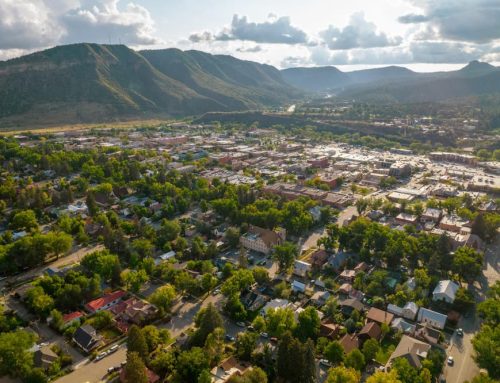
Durango: Destination Stewardship in Action
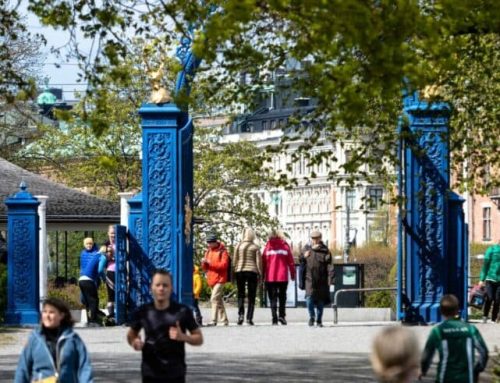
Djurgården Shows How To Collaborate

Rapa Nui: Memories of the Future
- About the ATTA
- Sustainability
- Our Initiatives
- Adventure Travel Conservation Fund
- Leadership & Team
- Internship Program
- Business Development
- Global Travel News
- Industry Spotlight
- Industry Voices
- Member News
- Regional News
- B2B Marketing
- Signature Events
- Market Activation
- Climate Action
- Storytelling
- B2C Marketing
- Event Calendar
- AdventureFAM Green France 2024
- Climate Action Summit 2024
- AdventureWeek Okinawa 2024
- AdventureNEXT Costa Rica 2024
- AdventureNEXT Fiji 2024
- AdventureELEVATE North America 2025
- AdventureConnect
- ATTA on the Road / Virtual
- Expert Nomination & Topic Suggestions
- Events Sustainability
- Sustainability Resource Center
- On-Demand / Webinars
- Inspiration
- Guide Standard
- Global Payment Resource
- Free Community Membership
- Become a Member
- ATTA Ambassadors
- Active Members
- Adventure Champions
- Community Books
- Case Studies

Shopping Cart
Shopping cart items, nepal now: tourism recovery after 2015’s earthquake.

Following the devastating 2015 earthquake that rocked Nepal’s capital, which killed over 8,500 people and displaced two million more, Nepal is gradually recovering, including its tourism industry, which comprises roughly 9% of its GDP.
During the 2016 ITB Berlin, ATTA Executive Director of Europe, Chris Doyle, participated on the Nepal Recovery Panel and showed “AdventureWeek-Rebound Nepal,” a short film produced by the ATTA’s Storytelling Team during its October 2015 return to Nepal. The film briefly addressed the ATTA and partner organization involvement ( Great Himalaya Trails , Tourism Cares , and ExOfficio with additional support from Princeton Tec and The North Face ), and that of a hosted delegation of international journalists and tour operators to convey the ATTA efforts led by ATTA President Shannon Stowell.
After an initial attempt immediately following the quake to help by bringing in outdoor and apparel gear supplies, the ATTA learned that it wasn’t effective as a disaster relief organization. “We needed to ask [the Nepalese] what they needed and then to listen ,” Doyle stated, “Everyone wants to do good, but unless you ask first, you'll never know what they need. In the end, the Nepalese wanted travelers to return. So, the ATTA mobilized to help spur a return of media and traveler interest to this Himalayan country.”
Encouraged by Stowell, the ATTA team simply re-considered its role -- “What are we good at?” -- and the answer was long-term, responsible tourism development and promotion, something that the ATTA could do well to help Nepal recover. “We decided we would volunteer an entire team to AdventureWeek Nepal, to try to encourage travelers to return to Nepal, a destination largely dependant on the tourism industry,” Doyle stated.

According to Deepak Joshi, Nepal Tourism Board CEO, “The damage to Nepal’s perceived image was much bigger - visitors in source markets still think Nepal is unvisitable.” Nepal has 75 districts and 10 national parks, yet only 10 districts and 1 park were affected. His goal is to communicate that while Nepal was hurt by this tragic event, it is ready for tourism.
“A lot of operators are remodeling products to adapt and get aggressive - the earthquake instigated this change. The events of last year allowed us to focus on the people, develop new products and to come out stronger! And now, everyone knows where Nepal is!”
Enlightening Dark Tourism in Nepal
PDF Version Also Available for Download.
Description
This study aims to examine the motivation, experience and benefits of Nepalese domestic tourists visiting the seismic memorial sites after the 25 April 2015 earthquake (known as Gorkha earthquake). A total of 403 surveys was gathered from seismic sites of Nepal (Kathmandu, Bhaktapur and Patan). Data were tested to analyze why the tourists are interested in disaster sites and how their experience during their visit impact the benefits of the visits. Additionally, partial least square structural equation modeling (PLS-SEM) was employed to test the relationships among tourist motivations, experiences, and perceived benefits at the dark tourism sites in Nepal. Among … continued below
Physical Description
vi, 75 pages
Creation Information
Thapa Magar, Asha December 2018.
This thesis is part of the collection entitled: UNT Theses and Dissertations and was provided by the UNT Libraries to the UNT Digital Library , a digital repository hosted by the UNT Libraries . It has been viewed 704 times. More information about this thesis can be viewed below.
People and organizations associated with either the creation of this thesis or its content.
- Thapa Magar, Asha
- Min, Jihye Major Professor
Committee Members
- Kim, Young Hoon
- Yang, Kiseol
- University of North Texas Publisher Info: www.unt.edu Place of Publication: Denton, Texas
Rights Holder
For guidance see Citations, Rights, Re-Use .
Provided By
Unt libraries.
The UNT Libraries serve the university and community by providing access to physical and online collections, fostering information literacy, supporting academic research, and much, much more.
Descriptive information to help identify this thesis. Follow the links below to find similar items on the Digital Library.
Degree Information
- Name: Master of Science
- Level: Master's
- Department: Department of Hospitality and Tourism Management
- College: College of Merchandising, Hospitality and Tourism
- Discipline: Hospitality and Tourism Management
- PublicationType: Master's Thesis
- Grantor: University of North Texas
This study aims to examine the motivation, experience and benefits of Nepalese domestic tourists visiting the seismic memorial sites after the 25 April 2015 earthquake (known as Gorkha earthquake). A total of 403 surveys was gathered from seismic sites of Nepal (Kathmandu, Bhaktapur and Patan). Data were tested to analyze why the tourists are interested in disaster sites and how their experience during their visit impact the benefits of the visits. Additionally, partial least square structural equation modeling (PLS-SEM) was employed to test the relationships among tourist motivations, experiences, and perceived benefits at the dark tourism sites in Nepal. Among the five motivational factors discovered, the empirical results depict that emotional reaction is the strongest factor of the dark tourism motivation, affecting both cognitive and affective experiences. Additionally, this study confirms that cognitive experience is more influenced by dark tourism motivations than affective experience. Among the four experience factors examined in the study, self-reflection is found to have the strongest impact of three aspects of perceived dark tourism benefits, such as knowledge gain, fulfillment, and appreciation. Overall, the findings of the study provide important implications to the management sectors of dark tourism sites, enhancing the importance of providing cognitive experiences (i.e. distributing the educational materials about the dark tourism events and offering the knowledgeable tour guide who can guide the sites) and affective experience of the tourists (storytelling about the events, organizing educational and volunteering programs at the sites). Further, this study contributes to the limited literature in the context of dark tourism and provide important managerial and practical implications based on the case of Nepal earthquake in 2015.
- Business Administration, Management
- Dark tourism
- Experience, Motivation and Benefits
- Gorkha Earthquake
- Thana tourism
Library of Congress Subject Headings
- Dark tourism -- Nepal -- Psychological aspects.
- Motivation (Psychology)
- Nepal Earthquake, 2015 (April 25)
- Tourists -- Nepal -- Psychology.
- Thesis or Dissertation
Unique identifying numbers for this thesis in the Digital Library or other systems.
- Accession or Local Control No : submission_1430
- Archival Resource Key : ark:/67531/metadc1404606
Collections
This thesis is part of the following collection of related materials.
UNT Theses and Dissertations
Theses and dissertations represent a wealth of scholarly and artistic content created by masters and doctoral students in the degree-seeking process. Some ETDs in this collection are restricted to use by the UNT community .
What responsibilities do I have when using this thesis?
Digital Files
- 82 image files available in multiple sizes
- 1 file (.pdf)
- Metadata API: descriptive and downloadable metadata available in other formats
Dates and time periods associated with this thesis.
Creation Date
- December 2018
Added to The UNT Digital Library
- Jan. 19, 2019, 9:34 p.m.
Description Last Updated
- Feb. 6, 2024, 2:38 p.m.
Usage Statistics
When was this thesis last used?
Geographical information about where this thesis originated or about its content.
Publication Place
- Denton, Texas ( University of North Texas )
Map Information

- Repositioning map may be required for optimal printing.
Mapped Locations
Interact with this thesis.
Here are some suggestions for what to do next.
Search Inside
- or search this site for other thesis or dissertations

Start Reading
- All Formats
Citations, Rights, Re-Use
- Citing this Thesis
- Responsibilities of Use
- Licensing and Permissions
- Linking and Embedding
- Copies and Reproductions
International Image Interoperability Framework

We support the IIIF Presentation API
Print / Share
Links for robots.
Helpful links in machine-readable formats.
Archival Resource Key (ARK)
- ERC Record: /ark:/67531/metadc1404606/?
- Persistence Statement: /ark:/67531/metadc1404606/??
International Image Interoperability Framework (IIIF)
- IIIF Manifest: /ark:/67531/metadc1404606/manifest/
Metadata Formats
- UNTL Format: /ark:/67531/metadc1404606/metadata.untl.xml
- DC RDF: /ark:/67531/metadc1404606/metadata.dc.rdf
- DC XML: /ark:/67531/metadc1404606/metadata.dc.xml
- OAI_DC : /oai/?verb=GetRecord&metadataPrefix=oai_dc&identifier=info:ark/67531/metadc1404606
- METS : /ark:/67531/metadc1404606/metadata.mets.xml
- OpenSearch Document: /ark:/67531/metadc1404606/opensearch.xml
- Thumbnail: /ark:/67531/metadc1404606/thumbnail/
- Small Image: /ark:/67531/metadc1404606/small/
- In-text: /ark:/67531/metadc1404606/urls.txt
- Usage Stats: /stats/stats.json?ark=ark:/67531/metadc1404606
Thapa Magar, Asha. Enlightening Dark Tourism in Nepal , thesis , December 2018; Denton, Texas . ( https://digital.library.unt.edu/ark:/67531/metadc1404606/ : accessed September 15, 2024 ), University of North Texas Libraries, UNT Digital Library, https://digital.library.unt.edu ; .
- Economy & Markets
- Digital Life

Nepal Earthquake 2015: Aftershocks Devastate Nepal’s Tourism Industry, Everest, Unesco Sites
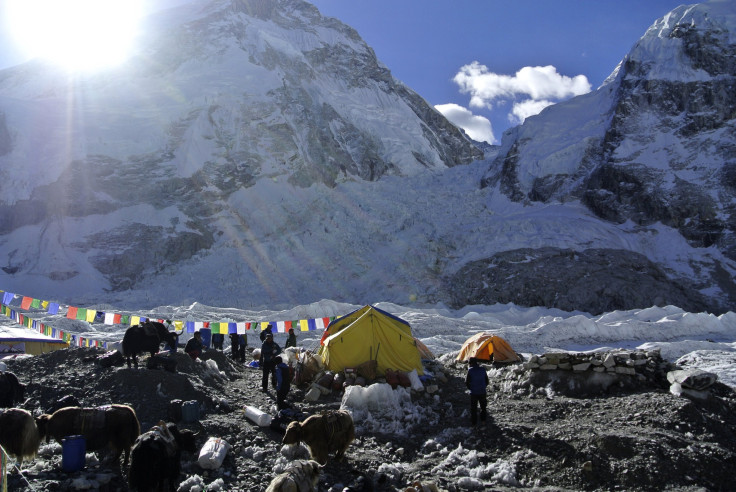
Finding the millions of dollars needed to rebuild and help survivors recover from Saturday’s earthquake will be particularly challenging for Nepal because the catastrophe that killed more than 3,200 people has also devastated the country’s crucial tourism sector.
Nepal attracts nearly 1 million foreigners each year who flock to the country’s World Heritage sites, UNESCO monuments, countless Buddhist and Hindu temples and, of course, its majestic mountains, including the legendary Everest. But tourism took a hit in 2014 after a Himalayan snowstorm in October killed at least 43 people, including 21 trekkers. And an avalanche on Mount Everest killing 16 local Sherpas last April resulted in the unofficial cancellation of the climbing season after guides protested the government’s failure to protect them.
Saturday's earthquake, which has devastated the country's infrastructure and killed thousands, including 17 people on Everest in an avalanche set off by the quake, dealt the final blow to the country's already-fragile but critical tourism industry.
“In the short term, Nepal is going to see its tourism fall to near zero levels,” travel industry analyst Henry Harteveldt told International Business Times by phone. “The devastation appears to be so widespread and extensive, it’s understandable.”
One of the world’s poorest countries, Nepal is an agricultural nation that relies on tourism to boost its economy. More than 8 percent of the country's $19.29 billion GDP in 2013 came from its tourism industry, the World Travel and Tourism Council reported. Foreign exchange earnings from tourism accounted for about 20 percent of the country’s export earnings in 2013, Nepal’s Ministry of Culture, Tourism and Civil Aviation said.
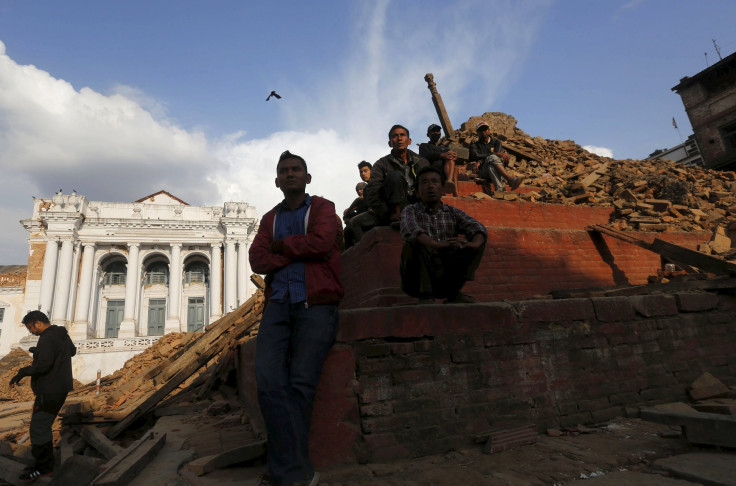
Those numbers are sure to take a hit. After the earthquake, many countries issued travel warnings. The U.S. Department of State urged its citizens to "exercise caution" regarding travel to Nepal, while the British government advised against "all but essential" travel to the country.
Travelers and tour agencies scrambled to cancel or postpone trips. “We have received calls to cancel almost 90 percent of close to 1,000 bookings to Nepal,” Sharat Dhall told India’s Business Standard . Dhall is president of Yatra, an online travel agency based in India that sends many tourists to the neighboring country.
Intrepid Travel, a global adventure tour operator that sends about 5,000 visitors to Nepal each year, canceled all trips to the country through May 11, at which point it will assess the viability of future tours. The agency is working to get its 20 groups currently in Nepal out of the country safely.
We have been in contact with our leaders in #Nepal and can confirm all groups in the area are safe. Thoughts are with those affected. — Intrepid Travel (@Intrepid_Travel) April 26, 2015
“The cancellations are for logistical reasons right now,” Steve Wroe, a manager at Intrepid based in Melbourne, Australia, told International Business Times by phone. “After that, it’s assess and see.”
Wroe said the country’s tourism industry can take small comfort in the fact that the quake hit near the end of Nepal’s peak tourism season, which spans from October through May. (Monsoons occur in summer, which is when the bulk of visitors stay away.)
“There will be a lengthy period of rebuilding,” Wroe said. “But it’s the tail end of the season, so there may be time in the upcoming six months for reconstruction before the next season.”
Still, there are concerns about how the quake will affect tourism in the long term.
“As I look at the photos, with so many UNESCO World Heritage sites damaged or, in some cases, destroyed, I wonder whether Nepal will be able to maintain its appeal to visitors,” Harteveldt said. “Certainly, trekking and climbing Everest will be popular, but I wonder if we will see as many people opt to do these activities? I don’t think we’ll know the answers for several months, at least, because we will need to see progress with the recovery. Right now, it’s triage.”
But Wroe, who has led many tours himself in Nepal, said many tourist sites were able to withstand long-term damage. “The main sites in Kathmandu are very, very sturdy. Boudhanath, a World Heritage site in Kathmandu, is quite a stable structure. It’s relatively unscathed.”
UPDATE: The world's largest & holiest #Tibetan Buddhist stupa, Boudhanath damaged in #NepalEarthquake #PrayForNepal pic.twitter.com/eiRpXmQ6TF — JigmeUgen (@JigmeUgen) April 25, 2015
Much of the rebuilding will result in more stable buildings and infrastructure that will benefit tourism in the long run, Wroe said. Some of those infrastructure upgrades were long overdue.
“In the long-term, the industry is going to rebound. I think mountaineers and walkers appreciate that it is a risky business going up into these areas. They probably think these [natural disasters] don’t happen every year, so they will think it’s safe enough,” Peter Goddard, managing director of TRI Consulting in Dubai, told GulfNews.com .
In the meantime, aid workers rushing to the region may help supplant some of the lost income local businesses will face as tourism disappears. “No doubt there will be a lot of people who want to contribute to the recovery and help rebuild,” Harteveldt said. “There’s hope the country may recoup some of its lost tourism revenue through these well-wishers’ efforts.”
Shenpenn Khymsar, a filmmaker and activist based in Vancouver, is one such well-wisher. Originally from Tibet, Khymsar has lived in Khatmandu and still has many friends there. Khymsar was so horrified by the images he’s seen of his beloved Nepal, he’s planning a trip in the next two weeks to offer help. Khymsar is crowd-funding to raise money for supplies and other aid.
Not all tourists have been deterred, however. Peter Schryvers, an urban planner from Calgary, Canada, had planned a two-week getaway to Nepal in May, and he does not intend to cancel his vacation unless infrastructure or travel issues make it impossible.
So tragic to hear what happened in Nepal. Decided to still go on my planned trip in May. Tourism can help to rebuild. — Peter Schryvers (@fusiliyyc) April 26, 2015
“My first thought was that maybe I shouldn’t go,” Schryvers said. “After I thought a little more about it, I realized it won’t be the same, but it will still be a good experience to go, to help in whatever way I can.”
Schryvers said he was planning on waiting a week or so before calling the hotel he booked in Kathmandu to make sure accommodations would still be available. In the meantime, he’s contacting aid organizations like Oxfam to see what kind of work he might be able to do while he’s on the ground there.
“Natural disasters are a double whammy for places like that because they lose the tourism too,” Schryvers said. “Part of helping is going to restaurants and hotels and spending money. They need money to keep their economy going.”
Photos I took during my last trip to Nepal. Such a beautiful country with such beautiful and caring people. pic.twitter.com/4HpNMwKvDd — Alain Uy (@theAlainUy) April 26, 2015
Alain Uy, an actor from Los Angeles who visited Nepal in 2012, said the country made a lasting impression on him. He wants to go back, and he urged other potential visitors to consider it, as well.
“The culture is still going to be there. The food is still going to be there. The history is still going to be there,” Alain said. “You can’t shake the core of that culture. It’s still going to be a vibrant, amazing, hospitable place.”
© Copyright IBTimes 2024. All rights reserved.
Vietnam Farmers Lose Their Blooms As Floods Claim Crops

France's First Lady Wins Lawsuit Against Online Rumor That She Is Transgender

'Historic': Bad Weather Slashes Wine Harvest In France's Jura

Israeli Authors Tackle Trauma Of October 7 With Words

On Cuban Streets, Mid-century Icons Face Challenge From New Rides

UN Experts Call For Global System To Trace Critical Minerals

Great Wolf Lodge To Offer Suite Designed Around Divisive Candy Corn

Gen Z, Millennials Skipping Parenthood Over The Price Tag: Study

Raygun's Revenge: Lampooned Aussie Breakdancer Tops World Rankings

Power Struggle: Serbia Eyes Nuclear Energy To Fuel Future
- 0 Shopping Cart

Nepal Earthquake 2015
A case study of an earthquake in a low income country (LIC).

Nepal, one of the poorest countries in the world, is a low-income country. Nepal is located between China and India in Asia along the Himalayan Mountains.
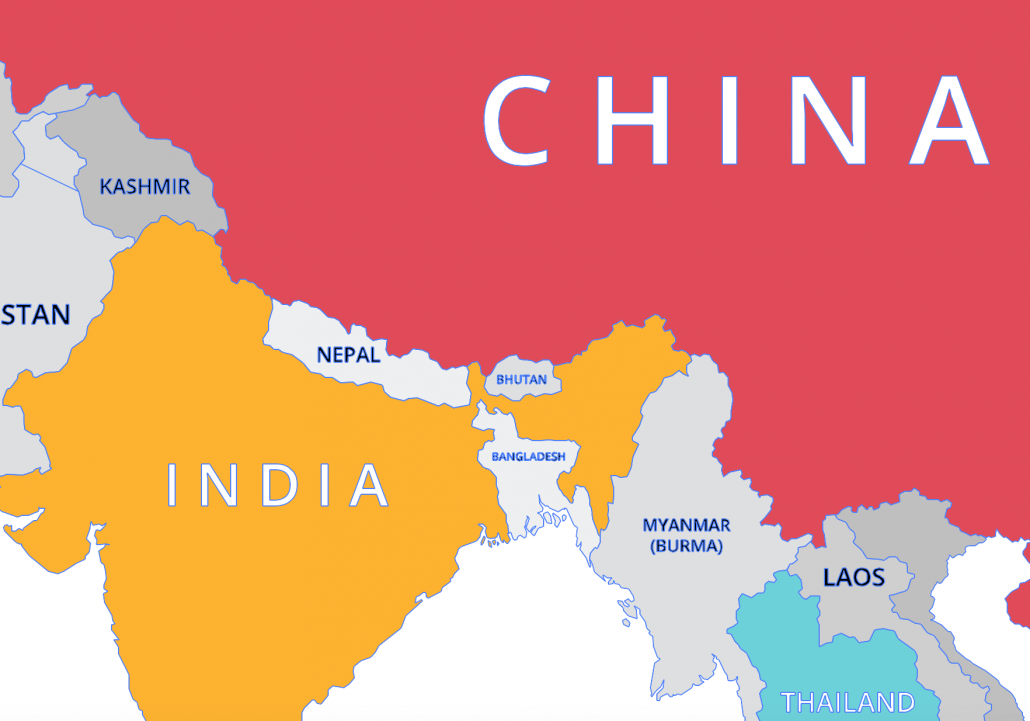
A map to show the location of Nepal in Asia
What caused the Nepal Earthquake?
The earthquake occurred on a collision plate boundary between the Indian and Eurasian plates.
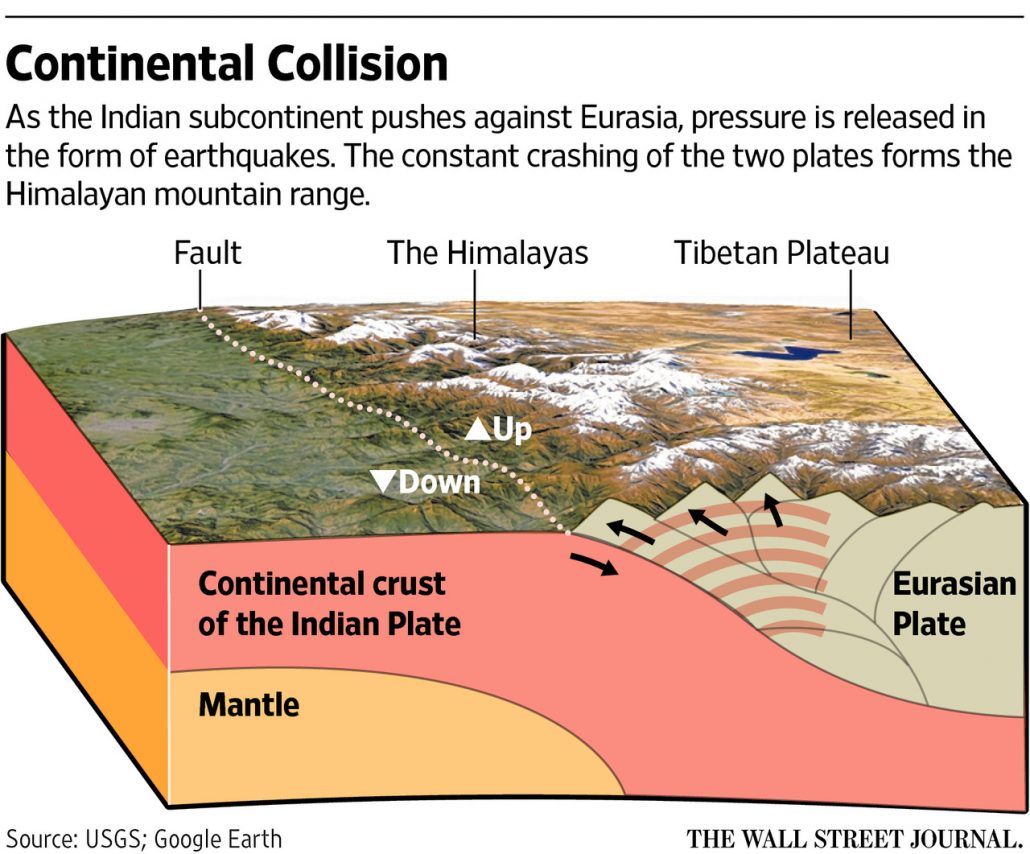
What were the impacts of the Nepal earthquake?
Infrastructure.
- Centuries-old buildings were destroyed at UNESCO World Heritage Sites in the Kathmandu Valley, including some at the Changu Narayan Temple and the Dharahara Tower.
- Thousands of houses were destroyed across many districts of the country.
Social and economic
- Eight thousand six hundred thirty-two dead and 19,009 injured.
- It was the worst earthquake in Nepal in more than 80 years.
- People chose to sleep outside in cold temperatures due to the risk of aftershocks causing damaged buildings to collapse.
- Hundreds of thousands of people were made homeless, with entire villages flattened.
- Harvests were reduced or lost that season.
- Economic losses were estimated to be between nine per cent to 50 per cent of GDP by The United States Geological Survey (USGS).
- Tourism is a significant source of revenue in Nepal, and the earthquake led to a sharp drop in the number of visitors.
- An avalanche killed at least 17 people at the Mount Everest Base Camp.
- Many landslides occurred along steep valleys. For example, 250 people were killed when the village of Ghodatabela was covered in material.
What were the primary effects of the 2015 earthquake in Nepal?
The primary effects of the 2015 earthquake in Nepal include:
- Nine thousand people died, and 19,000 people were injured – over 8 million people were affected.
- Three million people were made homeless.
- Electricity and water supplies, along with communications, were affected.
- 1.4 million people needed support with access to water, food and shelter in the days and weeks after the earthquake
- Seven thousand schools were destroyed.
- Hospitals were overwhelmed.
- As aid arrived, the international airport became congested.
- 50% of shops were destroyed, affecting supplies of food and people’s livelihoods.
- The cost of the earthquake was estimated to be US$5 billion.
What were the secondary effects of the 2015 earthquake in Nepal?
The secondary effects of the 2015 earthquake in Nepal include:
- Avalanches and landslides were triggered by the quake, blocking rocks and hampering the relief effort.
- At least nineteen people lost their lives on Mount Everest due to avalanches.
- Two hundred fifty people were missing in the Langtang region due to an avalanche.
- The Kali Gandaki River was blocked by a landslide leading many people to be evacuated due to the increased risk of flooding.
- Tourism employment and income declined.
- Rice seed ruined, causing food shortage and income loss.
What were the immediate responses to the Nepal earthquake?
- India and China provided over $1 billion of international aid .
- Over 100 search and rescue responders, medics and disaster and rescue experts were provided by The UK, along with three Chinook helicopters for use by the Nepali government.
- The GIS tool “Crisis mapping” was used to coordinate the response.
- Aid workers from charities such as the Red Cross came to help.
- Temporary housing was provided, including a ‘Tent city’ in Kathmandu.
- Search and rescue teams, and water and medical support arrived quickly from China, the UK and India.
- Half a million tents were provided to shelter the homeless.
- Helicopters rescued people caught in avalanches on Mount Everest and delivered aid to villages cut off by landslides.
- Field hospitals were set up to take pressure off hospitals.
- Three hundred thousand people migrated from Kathmandu to seek shelter and support from friends and family.
- Facebook launched a safety feature for users to indicate they were safe.
What were the long-term responses to the Nepal earthquake?
- A $3 million grant was provided by The Asian Development Bank (ADB) for immediate relief efforts and up to $200 million for the first phase of rehabilitation.
- Many countries donated aid. £73 million was donated by the UK (£23 million by the government and £50 million by the public). In addition to this, the UK provided 30 tonnes of humanitarian aid and eight tonnes of equipment.
- Landslides were cleared, and roads were repaired.
- Lakes that formed behind rivers damned by landslides were drained to avoid flooding.
- Stricter building codes were introduced.
- Thousands of homeless people were rehoused, and damaged homes were repaired.
- Over 7000 schools were rebuilt.
- Repairs were made to Everest base camp and trekking routes – by August 2015, new routes were established, and the government reopened the mountain to tourists.
- A blockade at the Indian border was cleared in late 2015, allowing better movement of fuels, medicines and construction materials.

Premium Resources
Please support internet geography.
If you've found the resources on this page useful please consider making a secure donation via PayPal to support the development of the site. The site is self-funded and your support is really appreciated.
Related Topics
Use the images below to explore related GeoTopics.
Previous Topic Page
Topic home, amatrice earthquake case study, share this:.
- Click to share on Twitter (Opens in new window)
- Click to share on Facebook (Opens in new window)
- Click to share on Pinterest (Opens in new window)
- Click to email a link to a friend (Opens in new window)
- Click to share on WhatsApp (Opens in new window)
- Click to print (Opens in new window)
If you've found the resources on this site useful please consider making a secure donation via PayPal to support the development of the site. The site is self-funded and your support is really appreciated.
Search Internet Geography
Latest Blog Entries
Pin It on Pinterest
- Click to share
- Print Friendly
Academia.edu no longer supports Internet Explorer.
To browse Academia.edu and the wider internet faster and more securely, please take a few seconds to upgrade your browser .
Enter the email address you signed up with and we'll email you a reset link.
- We're Hiring!
- Help Center

Nepals Earthquake-2015: Its Impact on Various Sectors

Related Papers
Hemant B Kaushik
Golam Rasul
On 25 April, Nepal experienced a catastrophic earthquake that not only took the lives of over 8,000 people, injured over 22,000, and displaced over 100,000, it also affected the livelihoods of over 2.28 million households and pushed an additional 700,000 people below the poverty line. In light of this, ICIMOD, together with the National Planning Commission of the Government of Nepal, has prepared this report to provide insights into how to restore, revive, and revitalize livelihoods focusing on the various socioeconomic challenges towards a strategic framework for designing and implementing actions, particularly those in the 14 most affected hill and mountain areas. This publication aims to complement the Post Disaster Need Assessment (PDNA) of the Government of Nepal by providing insights into the livelihood dimensions of the earthquake and its socioeconomic and livelihood impacts. It explores the strategic choices and options for developing resilient livelihoods post-earthquake, and details a number of key elements of a strategy for livelihood recovery to inform the Government of Nepal’s post-disaster policies and strategic plan. It provides guidance towards a long-term strategy for the transition from reconstruction and restoration to sustainable livelihoods that are more resilient to future disasters. It will add value to the existing knowledge base on developing resilient livelihoods post-earthquake, especially in mountain areas. It is envisioned that this report will be beneficial to the Government of Nepal and other development agencies in streamlining development efforts in the process of revitalizing livelihoods and developing resilient communities as the nation rebuilds.
Journal of Tourism and Hospitality Education
Dr. Him Lal Ghimire
Deepti Silwal
Foresnsic Disaster Analysis Report
Johannes Anhorn , Trevor Girard , Susan Brink , Bhubaneswari Parajuli
The 25 April 7.8 magnitude Gorkha earthquake and subsequent aftershocks, including the 7.3 magnitude earthquake in Dolakha, has caused devastation in Nepal on a scale not seen since the 1934 Nepal-Bihar Earthquake. According to the Government of Nepal, the Gorkha earthquake and aftershocks have severely damaged or destroyed nearly 900,000 buildings and approximately 2.3 million people continue to be displaced. The Gorkha earthquake created an unprecedented need for emergency shelter as well as temporary and transitional housing. A CEDIM-led research team conducted 284 household surveys in 177 locations spanning 27 Municipalities/VDCs and 7 districts. Types of shelter sites varied to include officially provided and spontaneous sites, located in urban and rural areas, and ranging from emergency shelter to temporary and transitional housing. The purpose of the study is to better understand the factors that increase vulnerability to being displaced. This report reviews the emergent issues with respect to decision processes of displaced households seeking shelter and temporary housing. We found that many displaced residents sought refuge close to their homes in open spaces, with housing damage, and the threat of landslides and aftershocks being the main drivers to seeking shelter. After the earthquake most households continued to visit their homes even if severely damaged or destroyed. Within the shelter sites, sanitation, water and food were the main issues. A majority of households also admitted to suffering from emotional difficulties, Nepal Earthquake 2015, and more than half confirmed that women in their households experienced additional problems. In regards to communicating their issues, we found that households speak to government office officials over other agencies. Furthermore, they communicate in person, with cellphones, internet and social media barely contributing in this regard. We also found locations where camp management committees were created to represent the shelter sites when speaking to officials and other agencies. These committees became a source of information as well as a conduit to have household needs heard and potentially resolved. Households understood that landslides were currently a major risk in many areas. Some suggested they will be less concerned once the monsoon is over, while others appeared to view the risk as a long term issue. Regardless, many stated they need to know more information about landslide risk, and some demanded that experts assess their area to confirm it is safe to live. We also found that many households want further information about how to build back better, in order to withstand future earthquakes, and many had their own ideas for doing so. Regarding future plans, many households were planning on staying in their current shelter during the monsoon with the majority of these being households from rural areas. And almost one third of households stated they would not be able to return to permanent housing within the next 10 years without financial assistance. The current situation is that many households have little money to rebuild or recover, as a large majority of households had experienced a severe impact on their ability to generate income. Many also have nowhere to go as homes were destroyed, and for some, their land has been wiped out by landslides. While the extent to which each household has been impacted by the earthquake varies, all are at a critical moment in planning for their future and re-establishing their home plays a major role. The aim of this report is to analyze the current shelter response situation with a view on emerging factors critical to forming an appropriate shelter policy which will account for the vulnerability of displaced populations in Kathmandu and affected areas across Nepal.
samjhana shrestha
Sharad Wagle
Journal of Nepal Geological Society
Ganesh Kumar Jimee
Morten Wendelbo , Sebastiano Mori , Federica La China , Leonardo Taccetti , Robert Zielonka , European Institute for Asian Studies
The response to the earthquakes in Nepal was among the strongest in history, seen from an international perspective, and given the severity of the calamities. Dozens of countries came to the aid of Nepal, some of them, such as India and Pakistan, within a few short hours. Nonetheless, an unnecessary amount of people were killed, injured or otherwise had their lives permanently altered. This report details many of the challenges experienced by international and Nepalese actors before, during and after the disaster. Here, the main findings are briefly summarized.
Samjwal Bajracharya

IMAGES
VIDEO
COMMENTS
This paper discusses the application of the Pacific Asia Travel Association's (PATA) risk and recovery strategy for Nepal following the April/May 2015 earthquake and aftershocks. The impact of the earthquake on tourism to Nepal, the establishment and evolution of PATA's Nepal Rapid Recovery Taskforce and strategic approaches to tourism ...
How Nepal's tourist industry is bouncing back two years on from devastating earthquake. April 25 marks two years since an earthquake left Nepal in ruins - but tourism is slowly recovering
The Gorkha Earthquake in Nepal is a case study of how tourism can aid in disaster recovery. On April 25th, 2015, the Gorkha region of Nepal was the epicenter of a 7.8 magnitude earthquake. Hundreds of aftershocks occurred for months afterward, leaving a serious impact on the country's infrastructure, including many heritage sites that double ...
It is clear that volunteer tourism has been a core element in the rapid recovery of tourism to Nepal since the 2015 earthquake (Beirman et al., 2018; de Swarte, 2015; Nicholls, 2018). Increasingly, tour operators and trekking programs include volunteer components in their programs, in response to increasing consumer demand for this form of ...
Impact of the 2015 Nepal Earthquake on Tourism. Figure 1, illustrates international tourism growth. trends to Nepal since 1962. By 2013, international vis-
Gorkha, the epicenter of devastating earthquake 2015 is one of the important tourist destinations of Nepal. Tourism is vulnerable sector that has been experiencing major crises from disasters.
The overall loss of Nepal caused by 2015 Gorkha earthquake was around $7 billion (Rijal, 2016). Similarly, the total cost of reconstruction estimated by National Reconstruction Authority (NRA) in ...
1.4 Impact of the 2015 Nepal Earthquake on Tourism Figure 1, illustrates international tourism growth trends to Nepal since 1962. By 2013, international visitation had reached 800,000 (Nepal Ministry of Tourism 2014). In 2014 Nepal attracted 790,118 tourists but due to the 2015 earthquake this dropped to 538,978, 32% less than the previous year ...
29 March 2016. Following the devastating 2015 earthquake that rocked Nepal's capital, which killed over 8,500 people and displaced two million more, Nepal is gradually recovering, including its tourism industry, which comprises roughly 9% of its GDP. During the 2016 ITB Berlin, ATTA Executive Director of Europe, Chris Doyle, participated on ...
This study aims to examine the motivation, experience and benefits of Nepalese domestic tourists visiting the seismic memorial sites after the 25 April 2015 earthquake (known as Gorkha earthquake). A total of 403 surveys was gathered from seismic sites of Nepal (Kathmandu, Bhaktapur and Patan). Data were tested to analyze why the tourists are interested in disaster sites and how their ...
The April 2015 Nepal earthquake (also known as the Gorkha earthquake) [7] [11] killed 8,962 people and injured 21,952 across the Nepal, India, China and Bangladesh. It occurred at 11:56 Nepal Standard Time on Saturday 25 April 2015, with a magnitude of 7.8M w [1] or 8.1M s [12] and a maximum Mercalli Intensity of X (Extreme).Its epicenter was east of Gorkha District at Barpak, Gorkha, roughly ...
People sit on the rubble of a temple after an earthquake in Kathmandu, Nepal April 26, 2015, a day after the 7.8 magnitude earthquake killed more than 3,200 people and devastated Kathmandu Valley ...
A map to show the location of Nepal in Asia. At 11.26 am on Saturday, 25th of April 2015, a magnitude 7.9 earthquake struck Nepal. The focus was only eight kilometres deep, and the epicentre was just 60 kilometres northwest of Kathmandu, the capital city of Nepal. At the time of the earthquake, Kathmandu had 800,000+ inhabitants.
Michele Metych. Nepal earthquake of 2015, severe earthquake that struck near Kathmandu in central Nepal on April 25, 2015. About 9,000 people were killed, many thousands more were injured, and more than 600,000 structures in Kathmandu and other nearby towns were either damaged or destroyed.
The 7.6 magnitude earthquake struck a large part of central Nepal and heavily affected the tourism business and livelihoods based on tourism. The overall economic loss due to the earthquake was equivalent to US$ 7 billion, and the disaster effect on tourism sector was estimated at 81241 million, 11.5 percent of total.
In this study, two types of secondary data were analyzed to examine the impact of the 8.1 magnitude. earthquake, which occurred in Nepal in April 2015, on tourism: (1) the number of tourist ...
Nepal Earthquake 2015Building Back Better, Safer and Greener for a More Resilient NepalThe Nepal earthquake in A. ril 2015 and its aftershocks resulted in huge loss of life, injury, and economic damage. Th. estimated value of damage and loss was US$7 billion1, a large proportion of it housing. Other sectors that require significant ...
The tourism industry is one of the largest growing commercial sector industries in the world which applies to Nepal, too. The main aim of this Bachelor's thesis was to project and present the negative effects of 2015 Nepal's earthquake for the tourism industry of Nepal and especially Nagarkot.
Uday Bhattarai, manager of tourism product and resource development, NTB, said, "Nepal has overcome the effect of the 2015 earthquake that wreaked havoc in our nation as well as the political ...
The 25 April 7.8 magnitude Gorkha earthquake and subsequent aftershocks, including the 7.3 magnitude earthquake in Dolakha, has caused devastation in Nepal on a scale not seen since the 1934 Nepal-Bihar Earthquake. According to the Government of Nepal, the Gorkha earthquake and aftershocks have severely damaged or destroyed nearly 900,000 ...
In Nepal, thousand s of tourists, tourism entrepreneurs and. tourism products were affected and damaged or destroyed by the 7.8 earthquake on. April 25, 2015. Earthquakes occ ur with no warning ...
A magnitude 6.9 earthquake struck eastern Nepal in 1988, killing over 700. In 2015, a magnitude 7.8 earthquake killed over 8,900 in central Nepal, many in the capital Kathmandu. Earthquake. The earthquake was felt by over 42.1 million people across Nepal, India and China. [5]